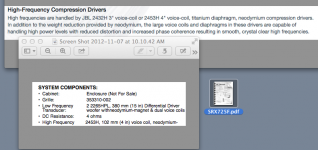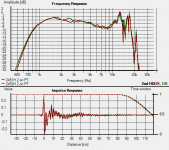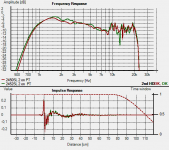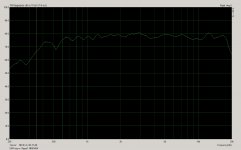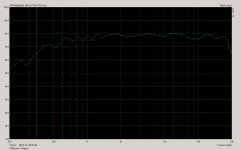Need a centre channel speaker to add to a 2 channel music system based on JBL-Pro 2447 compression drivers. The newer JBL 2453 should match in timbre and is a lot smaller and easier to hide.
Hopefully newer means technical improvement and not "made cheaper" but this is not "classic" JBL and there is almost no information on the 2453, so anyone here tried it?
The other almost unknown possibility is the D2430K. Only one comment last time I enquired, any updates?
Best wishes
David.
Hopefully newer means technical improvement and not "made cheaper" but this is not "classic" JBL and there is almost no information on the 2453, so anyone here tried it?
The other almost unknown possibility is the D2430K. Only one comment last time I enquired, any updates?
Best wishes
David.
Last edited:
Center loudspeaher should match those on the right and left
so that across-stage pans do not sound unnatural.
The need for a center channel, suggests the support of large, wide-screen video is anticipated.
Regards,
WHG
so that across-stage pans do not sound unnatural.
The need for a center channel, suggests the support of large, wide-screen video is anticipated.
Regards,
WHG
Not sure if you mean the centre speaker should match the others in sound or more particularly that they should be identical?
I have mirror L & R so the centre can't match identically in any case but naturally I want to match the sound. All the tests I have seen of various JBL 4" compression drivers show similar performance, hence my comment that the (untested) 2453 "should match in timbre". It would be nice to have that confirmed, but the acoustic environment difference between the centre and the side (corners) will probably dominate any speaker differences.
And yes it is for wide screen video projection. All in accord with ITU-R BS775-2 blah blah recommendations.
Best wishes
David
I have mirror L & R so the centre can't match identically in any case but naturally I want to match the sound. All the tests I have seen of various JBL 4" compression drivers show similar performance, hence my comment that the (untested) 2453 "should match in timbre". It would be nice to have that confirmed, but the acoustic environment difference between the centre and the side (corners) will probably dominate any speaker differences.
And yes it is for wide screen video projection. All in accord with ITU-R BS775-2 blah blah recommendations.
Best wishes
David
For home application, the 2452(SL) may well be better due to the aquaplas coating- assuming there is no 'sl' version of the 2453. It reduces distortion, particularly 3rd order.
David,All the tests I have seen of various JBL 4" compression drivers show similar performance, hence my comment that the (untested) 2453 "should match in timbre". It would be nice to have that confirmed, but the acoustic environment difference between the centre and the side (corners) will probably dominate any speaker differences.
I'd agree, the acoustic environment difference will probably dominate the driver differences.
I have heard the 2453 in JBL's SRX series cabinets, they seem cleaner above 8000 Hz than the 2 inch exit 2445, and are probably more similar to the 2447, which I don't believe I have heard.
The 2453 still does have the "JBL sound", for better or for worse.
Art
For home application, the 2452(SL) may well be better due to the aquaplas coating- assuming there is no 'sl' version of the 2453. It reduces distortion, particularly 3rd order.
The SL probably is better but I can't find one anywhere near the price of the 2453 - If you know of an inexpensive one...?
I have heard the 2453 in JBL's SRX series cabinets, they seem cleaner above 8000 Hz than the 2 inch exit 2445, and are probably more similar to the 2447, which I don't believe I have heard.
The old "classic" 2445 looks to have both worse distortion _and_ worse pattern control so your comments make sense.
You probably have heard the 2447 even if you didn't know - used in a lot of cinema and sound reinforcement systems. It is an actual improvement. Wanted to check that the 2453 wasn't "improved" only for JBL's bottom line, the sort of improvement that creates a deserved classic label for some older components.
Thanks for the replies.
Best wishes
David.
Last edited:
I have compared the 2452 (very similar to the 2453 it seems) to the 2450SL/2451, both with the same diaphragms installed, and preferred the 2450SL/2451 core by a large margin.
They measured almost identical in the >1khz range, but for a reason I could not measure (my distortion measurement where not accurate enough because they where dominated by the amp and mic) the 2452 sounded more "constrained". Maybe it has to do with the "optimized" magnet structure of the 2452: although they both are neodym, the 2452 is half the weight of the 2450SL/2451...
They measured almost identical in the >1khz range, but for a reason I could not measure (my distortion measurement where not accurate enough because they where dominated by the amp and mic) the 2452 sounded more "constrained". Maybe it has to do with the "optimized" magnet structure of the 2452: although they both are neodym, the 2452 is half the weight of the 2450SL/2451...
Not Even Close!
2447 & the 2453 compression drivers do not "match".
....................... 2447 ............... 2453
Diaphragm ….. 4" vc ............... 3" vc
Magnet …….... ferrite ............. neodymium
They acoustically and electrically differ in the design of their diaphragms, compliances, voice coils, magnetic structures, phase plugs and back cavities. For these and other related reasons, driver acoustic signatures will not "match" and the differences will be audible.
Regards,
WHG
Not sure if you mean the centre speaker should match the others in sound or more particularly that they should be identical?
I have mirror L & R so the centre can't match identically in any case but naturally I want to match the sound. All the tests I have seen of various JBL 4" compression drivers show similar performance, hence my comment that the (untested) 2453 "should match in timbre". It would be nice to have that confirmed, but the acoustic environment difference between the centre and the side (corners) will probably dominate any speaker differences.
And yes it is for wide screen video projection. All in accord with ITU-R BS775-2 blah blah recommendations.
Best wishes
David
2447 & the 2453 compression drivers do not "match".
....................... 2447 ............... 2453
Diaphragm ….. 4" vc ............... 3" vc
Magnet …….... ferrite ............. neodymium
They acoustically and electrically differ in the design of their diaphragms, compliances, voice coils, magnetic structures, phase plugs and back cavities. For these and other related reasons, driver acoustic signatures will not "match" and the differences will be audible.
Regards,
WHG
All the info I see on line says the 2453 is a 4" diaphragm, perhaps you are thinking of the 2432. Hard to keep all the JBL#s straight anymore...2447 & the 2453 compression drivers do not "match".
....................... 2447 ............... 2453
Diaphragm ….. 4" vc ............... 3" vc
Magnet …….... ferrite ............. neodymium
They acoustically and electrically differ in the design of their diaphragms, compliances, voice coils, magnetic structures, phase plugs and back cavities. For these and other related reasons, driver acoustic signatures will not "match" and the differences will be audible.
Regards,
WHG
At any rate, the differences will be audible, of course the differences between drivers that are the same model and diaphragm are often also audible. I have measured 6 dB differences between the last four JBL 2425 drivers I had..
I still agree with David, the acoustic environment difference will probably dominate the driver differences, though the difference between a 3" and 4" diaphragm would be more "different " than a neo and ceramic 4".
Art
Attachments
Oops
I do not remember where I got my disinformation regarding diaphragm diameter. Admittedly the signature differences between driver models will be less, but will remain audible during across-stage (across-screen) pans. You may expect room acoustics will not mask the differences between direct, high frequency, energy emanating from the individual horns under these conditions.
Regards,
WHG
All the info I see on line says the 2453 is a 4" diaphragm, perhaps you are thinking of the 2432. Hard to keep all the JBL#s straight anymore...
At any rate, the differences will be audible, of course the differences between drivers that are the same model and diaphragm are often also audible. I have measured 6 dB differences between the last four JBL 2425 drivers I had..
I still agree with David, the acoustic environment difference will probably dominate the driver differences, though the difference between a 3" and 4" diaphragm would be more "different " than a neo and ceramic 4".
Art
I do not remember where I got my disinformation regarding diaphragm diameter. Admittedly the signature differences between driver models will be less, but will remain audible during across-stage (across-screen) pans. You may expect room acoustics will not mask the differences between direct, high frequency, energy emanating from the individual horns under these conditions.
Regards,
WHG
I have compared the 2452 (very similar to the 2453 it seems) to the 2450SL/2451, both with the same diaphragms installed, and preferred the 2450SL/2451 core by a large margin.
They measured almost identical in the >1khz range, but for a reason I could not measure (my distortion measurement where not accurate enough because they where dominated by the amp and mic) the 2452 sounded more "constrained".
Thank you for the information. Was it a blind audition? So difficult to avoid prejudice when one driver is more impressive. Did you repeat audition to check?
Absolutely correct, as implied in the first post.All the info I see on line says the 2453 is a 4" diaphragm
Hard to keep all the JBL#s straight anymore...
The 243* are 3"
The 244* are 4"
The 245* are 4" but newer.
Indeed.OOPS
Whether it is audible remains to be tested. I expect the difference between ferrite and Neodymium at least to be inaudible.Admittedly the signature differences between driver models will be less, but will remain audible during across-stage (across-screen) pans.
You may expect room acoustics will not mask the differences between direct, high frequency, energy emanating from the individual horns under these conditions.
F.E. Toole's work makes me think that it is not so simple.
It also occurs to me that a constant sound almost never is panned across the screen. Much more typical is, say, a car that is in the distance on one side, close in the centre and then fades in the distance on the opposite side.
Of course, in an ideal world I would have 3 identical drivers but I don't think I will spend about $5000 to buy three JBL 245*SL's or similar TAD for a probably theoretical improvement.
Best wishes
David
Indeed
Each compression driver design will have a unique acoustic signature that is both measurable and audible. Whether you choose to hear it or not is another matter.
To achieve an identical set of drivers does not require the budget you suggest. The differences between TAD and JBL compression drivers are well known. It is not a theoretical issue. For some, the procurement of a set of matched, high performance drivers is a worthwhile investment that can be had for much less than $5,000.
Regards,
WHG
>snip<
Whether it is audible remains to be tested. I expect the difference between ferrite and Neodymium at least to be inaudible.
Each compression driver design will have a unique acoustic signature that is both measurable and audible. Whether you choose to hear it or not is another matter.
F.E. Toole's work makes me think that it is not so simple.
It also occurs to me that a constant sound almost never is panned across the screen. Much more typical is, say, a car that is in the distance on one side, close in the centre and then fades in the distance on the opposite side.
Of course, in an ideal world I would have 3 identical drivers but I don't think I will spend about $5000 to buy three JBL 245*SL's or similar TAD for a probably theoretical improvement.
To achieve an identical set of drivers does not require the budget you suggest. The differences between TAD and JBL compression drivers are well known. It is not a theoretical issue. For some, the procurement of a set of matched, high performance drivers is a worthwhile investment that can be had for much less than $5,000.
Regards,
WHG
It was not blind, but at least the responses were equalized, and the differences sounded obvious to my ears. I don't think I was biased before starting the comparisons (in fact I think I prefered the look of the newer 2452).Thank you for the information. Was it a blind audition? So difficult to avoid prejudice when one driver is more impressive. Did you repeat audition to check?
I made much of these comparisons with 2450 diaphragms (ribbed Ti with no aquaplas).
I don't have them anymore (at the end of the journey I kept the 2450SL cores with truextent diaphragms), so I cannot compare anymore...
Last edited:
David,Whether it is audible remains to be tested. I expect the difference between ferrite and Neodymium at least to be inaudible.
Back around 1991 I did extensive listening and measurement of JBL 2445 and 2425 compared to EVDH1 drivers, ultimately choosing the 3" titanium diaphragm EVDH1s for 1200 Hz up, after about 15 years of being a big JBL HF fan.
EV offered a Neo version of the DH1. It sounded ever so slightly better than the ceramic version, if not in an A/B test I certainly would not have been able to tell the difference.
Now, almost 20 years later, with my present hearing, I doubt I'd hear a difference at all, and if the very small differences were EQd out, I know I wouldn't be able to detect a difference.
I still can tell the difference between the DH1A and JBL drivers though 😉.
Art
Here some meat to go on the bones of the discussion
Truextent diaphragms measurements
The 2352 motor uses a higher power magnet material, and has a further optimised field geometry, along with a smaller cavity. I have found test data showing lower distortion- but would have to dig it out.
The 'sl' fram sounds markedly better to me- having directly a/b tested them at home right to left and swapped back double blind using my own drivers. I cannot comment on my own experiences of the 2450 motor vs 2452 as I have not owned the 2450.
Truextent diaphragms measurements
The 2352 motor uses a higher power magnet material, and has a further optimised field geometry, along with a smaller cavity. I have found test data showing lower distortion- but would have to dig it out.
The 'sl' fram sounds markedly better to me- having directly a/b tested them at home right to left and swapped back double blind using my own drivers. I cannot comment on my own experiences of the 2450 motor vs 2452 as I have not owned the 2450.
Last edited:
Here are some illustrations:
2435/2452/2450SL
The 2453 should be very similar to the 2452 (same size at least)
Then two 2452/2450SL cores measurements with the same diaphragms installed: Ti ribbed (equivalent to 2452H and 2451H drivers) and Ti SL (equivalent to 2452H-SL and 2450SL drivers).
As you can see the response are very similar across those cores, as long as you use the same diaphragm.
The 2452 core seems to have a little "boost" in the lower part of its range though, maybe due to its smaller backcap.
2435/2452/2450SL
The 2453 should be very similar to the 2452 (same size at least)
Then two 2452/2450SL cores measurements with the same diaphragms installed: Ti ribbed (equivalent to 2452H and 2451H drivers) and Ti SL (equivalent to 2452H-SL and 2450SL drivers).
As you can see the response are very similar across those cores, as long as you use the same diaphragm.
The 2452 core seems to have a little "boost" in the lower part of its range though, maybe due to its smaller backcap.
Attachments
It was not blind, but at least the responses were equalized, and the differences sounded obvious to my ears. I don't think I was biased before starting the comparisons (in fact I think I prefered the look of the newer 2452).
I made much of these comparisons with 2450 diaphragms (ribbed Ti with no aquaplas).
I don't have them anymore (at the end of the journey I kept the 2450SL cores with truextent ...
Thank you for the extra details and data. Your style of reasonably cautious reply in the absence of a blind test actually inspires more confidence than an assertive declaration.😉
And my compliments on the 2450 + TrueExtent. The most attractive specifications, even if the Beryllium does not improve the measurements in the way I expected.
David,
Back around 1991 I did extensive listening and measurement of JBL 2445 and 2425 compared to EVDH1 drivers, ultimately choosing the 3" titanium diaphragm EVDH1s for 1200 Hz up, after about 15 years of being a big JBL HF fan.
Is that a big fan of JBL or a fan of big JBL?😉 The 4" JBLs are a lot of driver but I have not compared the EV DH1. JBL has published its tests of the DH1 compared to the newer 2447, with the predictable result that the JBL was lower distortion. They actually showed (and conceded) that the EV horn was superior in some ways so it wasn't totally fixed. I have some 3" titanium JBLs on the way and will post results if anyone is interested.
EV offered a Neo version of the DH1. It sounded ever so slightly better than the ceramic version, if not in an A/B test I certainly would not have been able to tell the difference.
I wrote that I expect the difference between "ferrite and Neodymium is inaudible" but not necessarily so between a ferrite _driver_ and a neodymium version. I suspect it is due to physical differences to fit the different shapes.
The fact that the difference was very minor is consistent, as is the similarly minor difference between the 2452 and 2450 shown below.
I still can tell the difference between the DH1A and JBL drivers though 😉.
I trust blind tests more, but sometimes I don't need them either😉.
The 2352 motor uses a higher power magnet material, and has a further optimised field geometry, along with a smaller cavity. I have found test data showing lower distortion- but would have to dig it out.
The 'sl' fram sounds markedly better to me- having directly a/b tested them at home right to left and swapped back double blind using my own drivers. I cannot comment on my own experiences of the 2450 motor vs 2452 as I have not owned the 2450.
Thank you for the extra information. The physics, the test data, JBL's own use of the SL in the top-of-the-line DMS-1 monitor and blind test all concur that the SL 'fram sounds better and that this dominates any core differences. I am convinced!
Curious that you have seen lower distortion for the 2452 but "pos" preferred the 2450.
Here are some illustrations:
2435/2452/2450SL
The 2453 should be very similar to the 2452 (same size at least)
Then two 2452/2450SL cores measurements with the same diaphragms installed: Ti ribbed (equivalent to 2452H and 2451H drivers) and Ti SL (equivalent to 2452H-SL and 2450SL drivers).
As you can see the response are very similar across those cores, as long as you use the same diaphragm.
The 2452 core seems to have a little "boost" in the lower part of its range though, maybe due to its smaller backcap.
Excellent data, thank you🙂 I think you are correct - back cap is my first possibility too for that boost. Probably just detectable, but too small to make me pay for 3 new matched drivers😉
Thanks everyone. I now feel comfortable that the 2452 will be sufficiently close match to buy one with confidence..
Last edited:
Why not look for some 2447 to appear on ebay for example?
Here are some additional data provided by member gibber from the audioheritage.org forum:
Upgrade: SAM1HF or 2452H-SL in ScreenArray horn? - Page 2
And measurements he send me my email comparing 2447 and 2450 with same diaphragms.
Here are some additional data provided by member gibber from the audioheritage.org forum:
Upgrade: SAM1HF or 2452H-SL in ScreenArray horn? - Page 2
And measurements he send me my email comparing 2447 and 2450 with same diaphragms.
Attachments
Why not look for some 2447 to appear on ebay for example?
That is a possibility. Unfortunately there is not much surplus JBL in Australia and the 2447 is very heavy to ship from overseas. But the main problem is that the 2447 is bulky. Not convenient in my room layout because it would block a window and the horn would be pushed forward to make the problem worse.
So a 2453 at a reasonable price is an attractive option _if_ it is an acceptably close match. Plus it is fun to experiment a bit.
All your tests make me think you understand this😉
Thanks once more for the extra data. I have not yet worked out how to overlay them but they look extraordinarily similar.
This confirms my idea that the sonic difference between magnetic materials is vastly over-rated. There has been some misinformation on this subject even by usually very respectable authors.
Best wishes
David
Last edited:
- Status
- Not open for further replies.
- Home
- Loudspeakers
- Multi-Way
- JBL 2453 as centre ch. driver?
